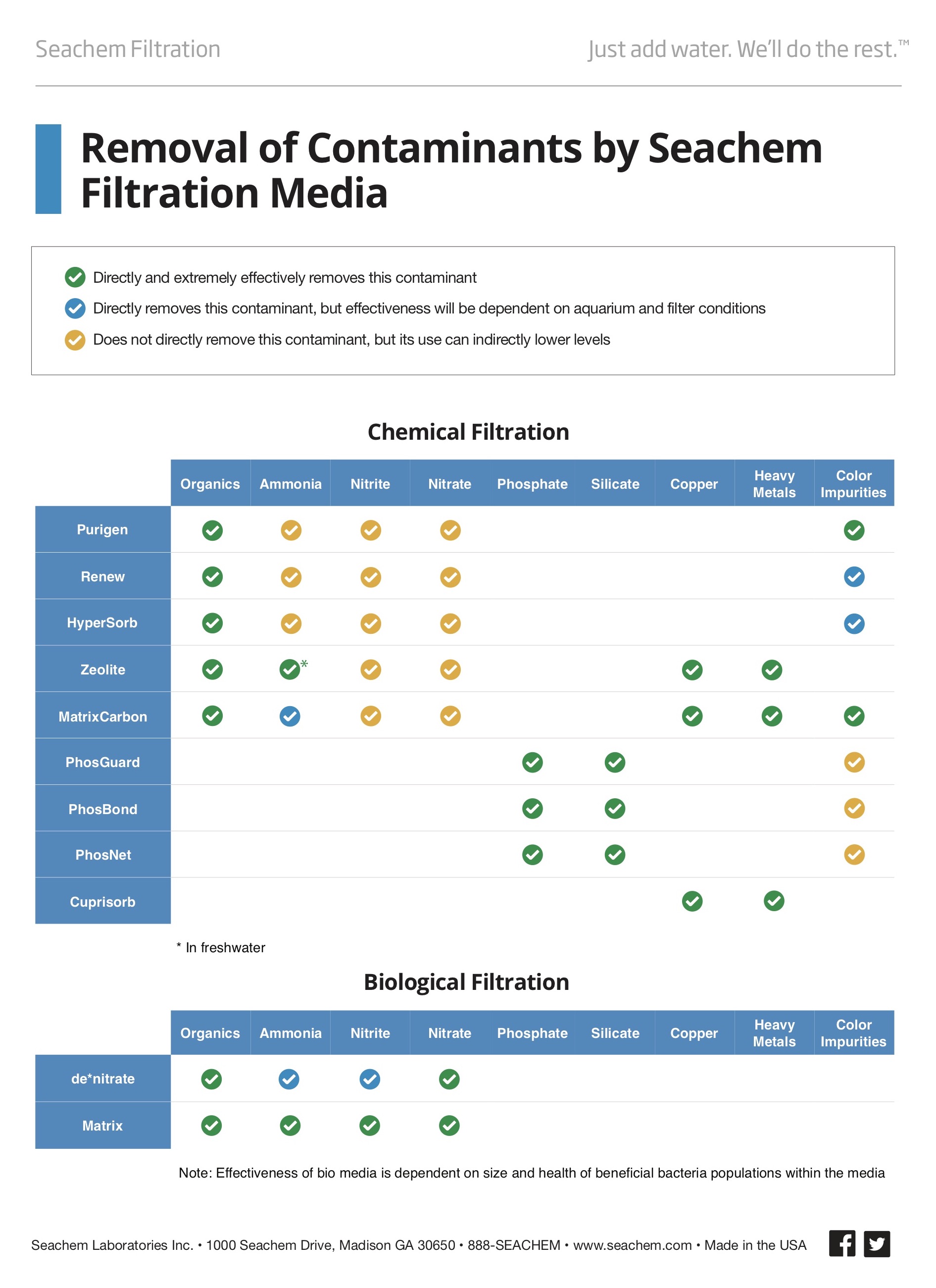The primary difference between the Seachem® filter medias is what they absorb. The graph below shows what each filter media will absorb from the water. See the notes below the graph for further clarification as to the role of each type of filter media in the aquarium.
See FAQ: How long will my Seachem® filter media last? for information on the varying lifespans of Seachem filter medias.
See FAQ: Where should Seachem® filter medias go in my filter? for information about where to place medias in your filter.

Chemical Filtration Medias
Purigen®
Absorbs organic molecules from the water, does not remove other types of contaminants. Great for targeted and aggressive removal of waste and color impurities from the water. Reducing organic waste will tend to slow the production of ammonia, nitrite, and nitrate, but Purigen® does not remove these chemicals from the water directly. Seachem® recommends healthy bio media like Matrix™ to manage ammonia, nitrite, and nitrate in the aquarium.
Renew™
Absorbs a broad range of contaminants from the water, works as a gentle alternative to carbon.
HyperSorb™
Absorbs organic molecules from the water, does not remove other types of contaminants. Great for targeted removal of waste and color impurities from the water, but is not as aggressive as Purigen®. Reducing organic waste will tend to slow the production of ammonia, nitrite, and nitrate, but HyperSorb™ does not remove these chemicals from the water directly. Seachem® recommends healthy bio media like Matrix™ to manage ammonia, nitrite, and nitrate in the aquarium.
Zeolite™
Removes heavy metals and organic waste in any type of aquarium, and directly absorbs ammonia in freshwater.
MatrixCarbon™
Broad-range filtration media which aggressively removes many types of aquarium contaminants, but is not targeted toward any one type of waste removal. Great for when the fish keeper is unsure of what type of filtration media is needed, or when waste levels are exceptionally high.
PhosGuard™
Removes phosphate and silicate. Made of aluminum oxide, which is an economical and aggressive form of phosphate removal.
PhosBond™
Removes phosphate and silicate. A blend of aluminum oxide and granular ferric oxide (GFO), resulting in a form of phosphate removal that is both economical and long-lasting.
PhosNet™
Removes phosphate and silicate. Made of granular ferric oxide (GFO) which has the highest capacity for phosphate removal of any of the Seachem® products, second only to phosfiltrum™ in the aquavitro® line.
CupriSorb™
Removes heavy metals. Does not remove any other type of contaminant. Recommended for aquaria which have previously been treated with copper or which are at high risk for heavy metal buildup.
Biological Filtration Media
This type of media is inert, but the shape of the media allows large colonies of beneficial bacteria to live in the media.
de*nitrate™
Designed to be used in a slow-flow filter of 50 GPH or less. In this environment, this media is capable of developing large colonies of anaerobic denitrifying bacteria that consume and remove nitrate from the system. At higher flow rates, the media will house only aerobic bacteria which removes ammonia and nitrite.
Matrix™
Can be used in any flow rate. This media is primarily designed to remove ammonia and nitrite, but is also capable of housing anaerobic bacteria that consumes nitrate at any flow rate.
0 Comments